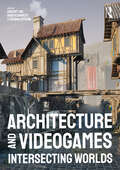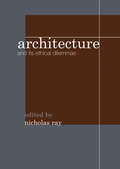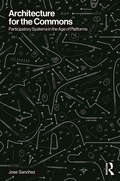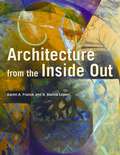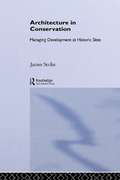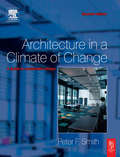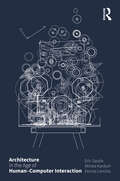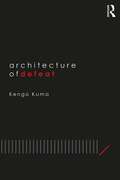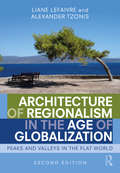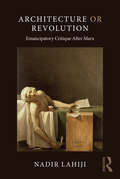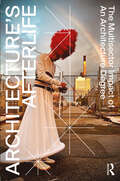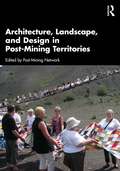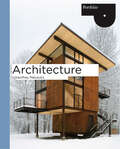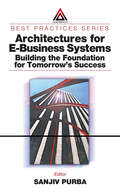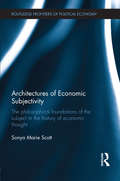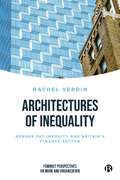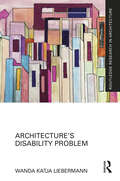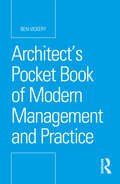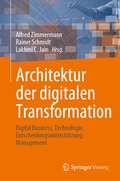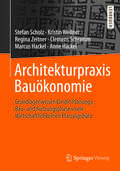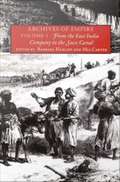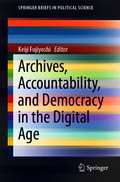- Table View
- List View
Architecture and Videogames: Intersecting Worlds
by Vincent Hui Ryan Scavnicky Tatiana EstrinaThis book explores and affirms the emergent symbiosis between videogames and architecture, including insights from a diverse range of disciplines.With contributions from authorities in both architecture and videogame industries, it examines how videogames as a medium have enlightened the public about the built environments of the past, offered heightened awareness of our current urban context, and presented inspiration for the future directions of architecture. A relatively nascent medium, videogames have rapidly transitioned from cultural novelty to architectural prophet over the past 50 years. That videogames serve as an interactive proxy for the real world is merely a gateway into just how pervasive and potent the medium is in architectural praxis. If architecture is a synthesis of cultural value and videogames are a dominant cultural medium of today, how will they influence the architecture of tomorrow?The book is split into seven sections: Cultural Artifacts, Historic Reproduction, Production Technologies, Design Pedagogy, Proxies and Representation, Bridging Worlds, and Projected Futures.
Architecture and its Ethical Dilemmas
by Nicholas RayA cast of leading writers and practitioners tackle the ethical questions that architects are increasingly facing in their work, from practical considerations in construction to the wider social context of buildings, their appearance, use and place in the narrative of the environment. This book gives an account of these ethical questions from the perspectives of historical architectural practice, philosophy, and business, and examines the implications of such dilemmas. Taking the current discussion of ethics in architecture on to a new stage, this volume provides an accumulation of diverse opinions, focusing on architects' actions and products that materially affect the lives of people in all urbanized societies.
Architecture for the Commons: Participatory Systems in the Age of Platforms
by Jose SanchezArchitecture for the Commons dives into an analysis of how the tectonics of a building is fundamentally linked to the economic organizations that allow them to exist. By tracing the origins and promises of current technological practices in design, the book provides an alternative path, one that reconsiders the means of achieving complexity through combinatorial strategies. This move requires reconsidering serial production with crowdsourcing and user content in mind. The ideas presented will be explored through the design research developed within Plethora Project, a design practice that explores the use of video game interfaces as a mechanism for participation and user design. The research work presented throughout the book seeks to align with a larger project that is currently taking place in many different fields: The Construction of the Commons. By developing both the ideological and physical infrastructure, the project of the Commons has become an antidote to current economic practices that perpetuate inequality. The mechanisms of the production and governance of the Commons are discussed, inviting the reader to get involved and participate in the discussion. The current political and economic landscape calls for a reformulation of our current economic practices and alternative value systems that challenge the current market monopolies. This book will be of great interest not only to architects and designers studying the impact of digital technologies in the field of design but also to researchers studying novel techniques for social participation and cooperating of communities through digital networks. The book connects principles of architecture, economics and social sciences to provide alternatives to the current production trends.
Architecture from the Inside Out: From the Body, the Senses, the Site, and the Community
by Karen A. Franck R. Bianca LeporiIntroducing a basis for design that transcends fixed notions of style and emerging technologies, this book emphasizes feeling, moving and the experiential. Since the book's initial publication in 2000, architects and writers have been drawn to a more sensory approach to architecture. But there is still a need to encourage and to illustrate the pursuit of design, not as a project, imposing preconceived ideas upon a situation, but as a process evolving from the inside - from movement, sensation, surroundings and a dialogue between architect and client. The authors describe such an approach that places human life, experience and materiality at the centre of design and that seeks out opportunities for discovery, growth and transformation. Karen A. Franck is an environmental psychologist who has taught for many years in the New Jersey School of Architecture. R. Bianca Lepori is a practicing architect in Italy with many years of experience in designing houses and maternity health care facilities.
Architecture in Conservation: Managing Development at Historic Sites (Heritage: Care-preservation-management Ser.)
by James StrikeOne of the problems faced by heritage organizations and museums is adapting old buildings to their needs or building new ones to fit in with historic sites. How exactly do you create a visitor's centre at Stonehenge? The real difficulty lies where the budget is minimal, and the potential damage to the environment or setting enormous. Architecture i
Architecture in a Climate of Change
by Peter F SmithRevised to incorporate and reflect changes and advances since it was first published the new edition of Architecture in a Climate of Change provides the latest basic principals of sustainability and the future of sustainable technology.Including new material on wind generation, domestic water conservation, solar thermal electricity as well as international case studies Architecture in a Climate of Change encourages readers to consider new approaches to building making minimum demand on fossil based energy.
Architecture in the Age of Human–Computer Interaction
by Eric Sauda Alireza Karduni Donna LanclosThis book investigates the spaces where architecture and computer science share a common set of assumptions and goals, using methods and objectives from architecture, ethnography, and human–computer interaction (HCI).Architecture and HCI depend on and borrow from each other, and even share some vocabulary in their divergent disciplinary agendas. The authors here unpack the past, present, and potential futures of architecture and the user interface, employing the lens of ethnography and ethnographic practices to launch this exciting cross-disciplinary inquiry. The goal is the creation of an interface that is able to connect the wide range of embodied architectural space, the modes of interaction afforded by computation, and the social process of creating meaningful places.This will be of great interest to upper-level students and academics in the fields of architecture, human–computer interaction, and ethnography.
Architecture of Business Intelligence: Aligning a Robust Technical Environment with Business Strategies
by Thomas H. Davenport Jeanne G. HarrisWhile improvements in technology's ability to store data can be astonishing, most organization's ability to manage, analyze, and apply data has not kept pace. In this chapter, the authors identify the technology, data, and governance processes needed for analytical competition. This chapter was originally published as Chapter 8 of "Competing on Analytics."
Architecture of Defeat
by Kengo KumaKengo Kuma, one of Japan’s leading architects, has been combining professional practice and academia for most of his career. In addition to creating many internationally recognized buildings all over the world, he has written extensively about the history and theory of architecture. Like his built work, his writings also reflect his profound personal philosophy. Architecture of Defeat is no exception. Now available in English for the first time, the book explores events and architectural trends in the twentieth and twenty-first centuries in both Japan and beyond. It brings together a collection of essays which Kuma wrote after disasters such as the destruction of the World Trade Center in New York City on 9/11 and the earthquake and tsunami that obliterated much of the built landscape on Japan’s northern shore in a matter of minutes in 2011. Asking if we have been building in a manner that is too self-confident or arrogant, he examines architecture’s intrinsic—and often problematic—relationship to the powerful forces of contemporary politics, economics, consumerism, and technology, as well as its vital ties to society. Despite the title, Architecture of Defeat is an optimistic and hopeful book. Rather than anticipating the demise of architecture, Kuma envisages a different mode of conceiving architecture: guided and shaped by more modesty and with greater respect for the forces of our natural world. Beautifully designed and illustrated, this is a fascinating insight into the thinking of one of the world’s most influential architects.
Architecture of Regionalism in the Age of Globalization: Peaks and Valleys in the Flat World
by Liane Lefaivre Alexander TzonisThis book remains the definitive introductory text on the theory and history of regionalist architecture in the context of globalization. It addresses issues of identity, diversity, community, inequality, geopolitics, and sustainability. From the authors who coined the concept of Critical Regionalism, this new edition enhances the understanding of the complex evolution of regionalism and its rival, unchecked globalization. Covering a rich selection of the most outstanding examples of design from all over the world, Liane Lefaivre and Alexander Tzonis, who introduced the concept of Critical Regionalism to architecture, present an enlightening, concise historical analysis of the endurance of regionalism and the ceaseless drive for globalization. New case studies include current cutting-edge projects in Japan, Africa, China, and the United States. Architecture of Regionalism in the Age of Globalization offers undergraduate and graduate students of architecture, geography, history, environmental studies, and other related fields an accessible, vivid, and scholarly perspective of this major conflict as it relates to the design and to the future of the human-made environment.
Architecture or Revolution: Emancipatory Critique After Marx
by Nadir LahijiBy linking building theory to the emancipatory project of critique advanced by radical thinkers in our time, this work investigates the key conceptual and historical elements that culminate in an emancipatory theory of building entitled: 'Toward a philosophy of shelter’. Taking Marx as its only resource, this work proceeds with the conviction that our era is contemporaneous to Marx’s historical era. This means ‘not judging the validity of Marx from the perspective of the historical situation’, but rather, ‘demonstrating the validity of a Marxian perspective for a singular historical situation’, as ours. This work will therefore translate this perspective into seeing the situation of architecture through the eyes of Marx. All those concerned with the predicament in our current condition in which architecture must play a major social role in upholding the universal value of what Alain Badiou calls 'generic humanity' will take an interest in this work. In particular, architects, critics, scholars, and students inside the field of architecture who would be seeking the application of this universal value to a new theory of building will be a welcoming audience for this work.
Architecture's Afterlife: The Multisector Impact of an Architecture Degree
by Harriet Harriss Roberta Marcaccio Michela Barosio Dag Boutsen Andrea Čeko Haydée De Loof Johan De Walsche Santiago Gomes Mia Roth-Čerina Carla Sentieri Neal Sashore Federica Vannucchi Hanne Van ReuselAlmost 40% of architecture graduates choose not to practise as architects. Instead, by ‘leaving’ their chosen profession, this surprisingly large but vastly overlooked cohort are making significant contributions to a wide range of other sectors, from politics to videogame design, demonstrating that architectural training can be a pathway to roles, and even leadership opportunities, across a variety of other professions.Architecture’s Afterlife is the first book to examine the sectors into which these graduates migrate, and to identify the transferable skills that are learned, but not always taught, in their degree programmes, and that prove most useful in their new careers.The book – a result of a three-year pan-European study funded by Erasmus+ – provides a roadmap for increasing graduate employment, addressing skills shortages across all sectors and adapting curricula to changing professional landscapes. It is therefore essential reading for all those responsible for curriculum design and delivery in architecture and other disciplines, including deans, professors, postgraduate researchers and policy makers, as well as students and professionals seeking to expand their career prospects.
Architecture, Landscape, and Design in Post-Mining Territories
by Post-Mining NetworkThis edited collection explores how architects, planners, and landscape architects can engage with former mining sites and communities.Chapters investigate how to move from an extractivist system towards a territorialist project, working towards the reappropriation of territorial resources after centuries of subordination of local and immigrant populations. The first part reviews cases from European sites, including examples from France, Germany, and Romania that highlight intangible heritage as the subject of a territorial project. A special focus is placed on the coalfields of northern France, a UNESCO World Heritage site since 2012, where many experimental projects are being carried out. The second part explores the great American landscapes transformed by the extractive industry in the United States, Brazil, and Chile. Fully illustrated throughout, this book features photos showcasing architectural and landscape achievements, as well as drawings of future projects. Contributors respond to the design challenges of post-mining landscapes, foreshadowing new and varied transformative horizons. The cases present a rich and articulate collection of ‘on-the-ground’ projects.This book is essential for practitioners and students of architecture and urban planning, as well as associations and political and technical actors in post-mining communities.
Architecture: An Introduction (Portfolio)
by Geoffrey MakstutisThis book offers a thorough introduction to the entire field of architecture, outlining the steps that are normally taken in becoming a qualified architect, from initial education right through to professional practice, as well as how to apply this architectural training in other fields. Complete with feature spreads on individual projects, Architecture: An Introduction's broad, up-to-date approach unites history, theory and practice. Subjects covered include how to develop a brief with a client; taking an idea from brief to project; types of visual presentation including drawings, models and computer renderings; project planning and management; the diverse roles within a company; and the future of architectural practice. This book is a must for anyone considering taking an architecture course or just beginning one.
Architectures for E-Business Systems: Building the Foundation for Tomorrow's Success (Best Practices)
by Sanjiv PurbaAs dot.com companies grapple with rigid market conditions and we keep hearing how the big technology players are being punished on Wall Street, it becomes easy to think of the Internet as a fad. The Internet frenzy may have subsided, but interest in the Internet as a business and marketing tool is still strong. It will continue to impact organizati
Architectures of Economic Subjectivity: The Philosophical Foundations of the Subject in the History of Economic Thought (Routledge Frontiers of Political Economy)
by Sonya ScottThe history of European economic thought has long been written by those seeking to prove or disprove the truth-value of the theories they describe. This work takes a different approach. It explores the philosophical groundwork of the theoretical structure within which economic subjects are presented. Demonstrating how the subjects of economic texts tend to be defined in and through their relationship to knowledge, this study addresses the epistemological constitution of subjectivity in economic thought.
Architectures of Inequality: Gender Pay Inequity and Britain’s Finance Sector (Feminist Perspectives on Work and Organization)
by Rachel VerdinAvailable open access digitally under CC-BY-NC-ND licence.The gender pay gap is economically irrational and yet stubbornly persistent. Focusing on the UK finance industry which is known for its gender pay disparity, this book explores the initiatives to fix gendered inequities in the workplace. Rachel Verdin crafts a unique framework, weaving extensive organizational data with women's lived experiences. Interviews uncover gaps in pay transparency, obstacles hindering workplace policies and the factors that are stalling progress for the future. This is an invaluable resource that offers key insights into gender equality and EDI measures shaped by legal regulations as well as corporate-driven initiatives.
Architecture’s Disability Problem (Routledge Research in Architecture)
by Wanda Katja LiebermannArchitecture’s Disability Problem explores the intersection of architecture and disability in the United States from the perspective of professional practice. This book uncovers why, despite the profound effect of the Americans with Disabilities Act on the architectural profession, there has been so little interest in design for disability in mainstream architecture. To counter this, the book investigates alternative approaches to designing with disability, through three case studies. These showcase both buildings and how design processes driven by disabled people shape design and professional roles.Combining historical research, formal and discourse analysis, and interviews with people who design, construct, use buildings, and advocate for access, the book develops a social understanding of how the buildings work at functional, affective, and symbolic levels. Architecture’s Disability Problem is aimed at three primary readers: practicing architects, architectural scholars, and members of disability scholar-activist communities. Grounded in detailed design studies, the author hopes to unearth the social meaning-making of architecture related to disability. Ultimately, the book makes an argument for a focus on disability in its own right—as well as on the body—in place of the dominance of formal, object-oriented approaches.This book presents and argues for a fundamental shift in the way architectural education, policy, and practice views and engages with disability. It will be key reading for students, researchers, practitioners and policy-makers.
Architect’s Pocket Book of Modern Management and Practice (Routledge Pocket Books)
by Ben VickeryThis book is an easily digestible guide to the management and practice knowledge needed to establish and run an architectural practice. It is of particular interest to those starting out in the profession and to students, whilst also being useful to architects more widely who need succinct information to assist them in the daily management of their work. The book sits beside the Architect’s Legal Pocket Book providing legal information and the Architect’s Pocket Book providing guidance in design. It covers all the main management and practice topics relevant to the running of an architectural business including setting up the company, the profession, project management, fees, office management, financial management and teamwork. It also looks at the state of the construction industry and the architectural profession today, new forms of practice, and how the profession is changing. The book is interweaved with pearls of wisdom and experience and reflections from architects, bringing the topics to life and aiding the reader’s understanding.
Architektur der digitalen Transformation: Digital Business, Technologie, Entscheidungsunterstützung, Management
by Lakhmi C. Jain Rainer Schmidt Alfred ZimmermannDieses forschungsorientierte Buch enthält wichtige Beiträge zur Gestaltung der digitalen Transformation. Es umfasst die folgenden Hauptabschnitte in 20 Kapiteln:- Digitale Transformation- Digitales Geschäft- Digitale Architektur- Entscheidungshilfe- Digitale Anwendungen Es konzentriert sich auf digitale Architekturen für intelligente digitale Produkte und Dienstleistungen und ist eine wertvolle Ressource für Forscher, Doktoranden, Postgraduierte, Absolventen, Studenten, Akademiker und Praktiker, die sich für die digitale Transformation interessieren.
Architekturpraxis Bauökonomie: Grundlagenwissen für die Planungs-, Bau- und Nutzungsphase sowie Wirtschaftlichkeit im Planungsbüro
by Regina Zeitner Stefan Scholz Kristin Wellner Clemens Schramm Marcus Hackel Anne HackelDiese Lehrbuch stellt das komplexe Tätigkeitsfeld des Architekten aus planungs- und bauökonomischer Sicht dar. Die Aufgaben des Architekten werden prozessorientiert im Sinne eines Qualitätsmanagementsystems vermittelt beginnend bei den Kernprozessen der Planung bis zur Realisierung des Bauvorhabens.
Archives of Empire: Volume I * From the East India Company to the Suez Canal
by Barbara Harlow Mia CarterA rich collection of primary materials, the multivolume Archives of Empire provides a documentary history of nineteenth-century British imperialism from the Indian subcontinent to the Suez Canal to southernmost Africa. Barbara Harlow and Mia Carter have carefully selected a diverse range of texts that track the debates over imperialism in the ranks of the military, the corridors of political power, the lobbies of missionary organizations, the halls of royal geographic and ethnographic societies, the boardrooms of trading companies, the editorial offices of major newspapers, and far-flung parts of the empire itself. Focusing on a particular region and historical period, each volume in Archives of Empire is organized into sections preceded by brief introductions. Documents including mercantile company charters, parliamentary records, explorers' accounts, and political cartoons are complemented by timelines, maps, and bibligraphies. Unique resources for teachers and students, these books reveal the complexities of nineteenth-century colonialism and emphasize its enduring relevance to the "global markets" of the twenty-first century. Tracing the beginnings of the British colonial enterprise in South Asia and the Middle East, From the Company to the Canal brings together key texts from the era of the privately owned British East India Company through the crises that led to the company's takeover by the Crown in 1858. It ends with the momentous opening of the Suez Canal in 1869. Government proclamations, military reports, and newspaper articles are included here alongside pieces by Rudyard Kipling, Charles Dickens, John Stuart Mill, Karl Marx, Benjamin Disraeli, and many others. A number of documents chronicle arguments between mercantilists and free trade advocates over the competing interests of the nation and the East India Company. Others provide accounts of imperial crises--including the trial of Warren Hastings, the Indian Rebellion (Sepoy Mutiny), and the Arabi Uprising--that highlight the human, political, and economic costs of imperial domination and control.
Archives, Accountability, and Democracy in the Digital Age (SpringerBriefs in Political Science)
by Keiji FujiyoshiThis book is the first attempt to introduce the current status of archival practices in Japan as well as the basic views of the populace on making records accessible to English readers. In general, Japan has not paid sufficient attention to keeping and utilizing records except in the field of historical research. This book thus examines Japanese attitudes about history, records management, information acts, the status of archivists of the constitution, and genealogical research practices and a description of archives. Consequently, such investigations clarify how both private and public archives function or fail to do so in those spheres of Japanese society. In addition, this book presents the efforts in wartime record keeping in Australia, which is significantly different from how the Japanese deal with such records. This book therefore provides a clear and concrete picture of the status of current archival practices in Japan and the thinking that underlies them. On the basis of such examinations, this book enables readers to understand to what extent and how the past affects the present through archives, to recognize the importance of archives, and to respect the past in order to maintain and develop perspectives in people’s lives.
Arck Systems
by Ian I. LarkinThe Arck Systems series of cases describes the dilemmas faced by a senior sales manager in determining a sales compensation plan at an enterprise software company. The existing compensation plan is aggressive and highly rewards "star" performers. The cases track a series of changes the manager makes to the sales compensation plan in response to negative and unintended consequences of the existing system. The cases illustrate the trade-offs inherent in incentive plans (even outside sales environments) and presents a framework for the design and management of incentive systems. It also is useful in addressing employee response to incentive system change.
Arck Systems (B)
by Ian I. LarkinThe Arck Systems series of cases describes the dilemmas faced by a senior sales manager in determining a sales compensation plan at an enterprise software company. The existing compensation plan is aggressive and highly rewards "star" performers. The cases track a series of changes the manager makes to the sales compensation plan in response to negative and unintended consequences of the existing system. The cases illustrate the tradeoffs inherent in incentive plans (even outside of sales environments) and presents a framework for the design and management of incentive systems. It also is useful in addressing employee response to incentive system change.
